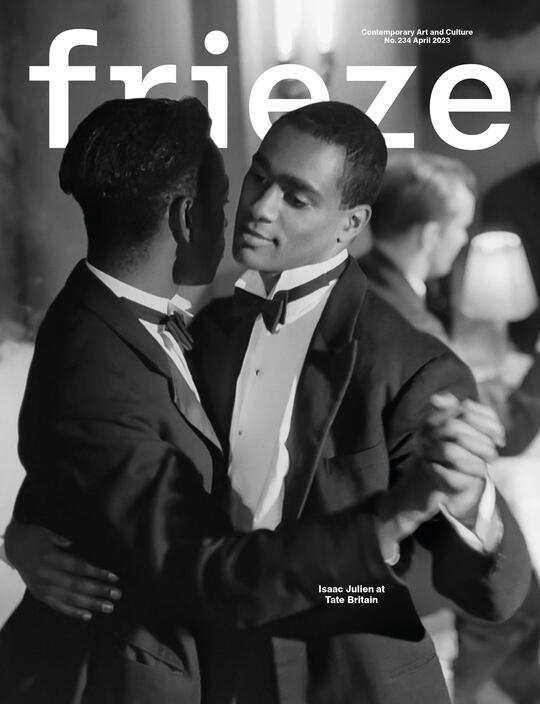Minjung Kim’s Art Is an Extension of Her Own Skin
The artist shares her Zen-like approach to using Korean hanji paper
The artist shares her Zen-like approach to using Korean hanji paper

I last encountered Minjung Kim’s work in the autumn of 2020, during her survey at the Hill Art Foundation in New York. I remember peering at a piece from her series ‘Mountain’ (2005–ongoing), in which scalloped layers of ink transition from black tones at the bottom of the plane to light-grey washes at the top, instilling the illusion of summits rolling away to an atmospheric distance. Looking at that tranquil work, admiring the way the diluted ink crept along the grain of the translucent paper, I suddenly thought of my blood vessels blooming invisibly underneath my skin like the filigreed edges of the pooled ink.
Kim, indeed, has spoken about paper – specifically Korean hanji – as an extension of her own skin. In a 2021 conversation between Kim and Hans Ulrich Obrist at Gallery Hyundai, the artist stated: ‘I feel the material becomes a part of myself. Paper is my skin.’ Hanji isn’t just the ground for her work, it’s also its subject. ‘Paper is the perfect material,’ she told me recently over Zoom. ‘It’s transparent, it’s honest; it has a strong character.’ Kim nurtured her connection to the material early: she spent her childhood playing with scraps of hanji from her father’s print shop in Gwangju during the 1960s. It has remained her favoured medium through an adolescent apprenticeship with the artist Kang Yeon-Gyun; a formal education at Hongik University in Seoul and Brera Academy of Fine Arts in Milan; and her current practice at studios in Saint Paul de Vence, Venice and New York.

A piece from her ‘Mountain’ series will be one of four large-scale works that Kim plans to show at the Gwangju Biennale. Mountain (2022) feels looser, freer than previous iterations: some of the cordilleras skitter to twice the width of others and the ink-bleeds seem less ridged, as if applied more quickly with the brush. ‘There’s no planning to this work,’ she tells me. ‘It all comes the moment I make the painting.’ The innate faith that underpins the rhythms of a single work – how the ink will spread, when the hanji is primed for the next layer – both mirrors and overshadows the arc of her oeuvre. Innovation comes to Kim naturally, haltingly and non-linearly: since its inception, her ‘Mountain’ series has served as a mental and spiritual reset to which she returns even as she develops new series. ‘When you’re a pianist, you start by playing scales,’ she analogizes. ‘I go back to the “Mountain”, always.’
Indeed, Kim conceives of her latest series, ‘Timeless’ (2020–22), as an interpretation of ‘Mountain’. Instead of curved, alpine-like undulations, however, the constitutive unit is a flat, horizontal swathe of paper. She applies ink – always from light to dark, an aesthetics of accretion – to a sheet of hanji. She uses a knife to cut the paper into thin strips; carefully burns the edges of each with a stick of incense, excavating the raw tooth of the grain; then adheres them to another sheet with glue. In her second piece for the Gwangju Biennale, Timeless (2022), the bottom corners are almost incomprehensibly dark; slowly, irregularly, the ink lightens as it edges upward until it stops abruptly, leaving an expanse of blank paper that reads like an empty sky above a horizon.

Kim’s zen-like approach to her work, alongside her study of and residence in Europe and the US, has led her to be viewed as an artist that bridges the so-called East-West dichotomy. Those categorizations, however, feel more descriptive than substantive: the work itself bristles under such constraints. Her use of incense to singe hanji, for instance, seems less a reference to the burning of Joss paper in Chinese religious ceremonies than a hermetic and wholly idiosyncratic exploration of the properties and limits of the materials.
For History (2022), a work in an eponymous series begun in 2020, Kim layers oblong shapes with ink – thicker at top and bottom, thinner in the middle – then tears the paper open, gently, with her hands, before gluing the pieces down on another sheet. During our Zoom call, she runs her bare fingers fondly along the fibrous zig-zag of the hanji: a wound inflicted, then sutured together again. I can’t help but draw a connection to Kim’s geographic dislocations: after decades spent in Europe and the US, the biennial represents a sort of homecoming to Gwangju. ‘It’s a good feeling,’ she tells me. ‘I come back with my own journey.’
This article first appeared in frieze issue 234 as part of a dossier with the headline ‘Four Artists to Watch in Gwangju'.
Main image: Minjung Kim, Mountain, 2022, 1.3 × 1.3 m. Courtesy: the artist © Minjung Kim






















